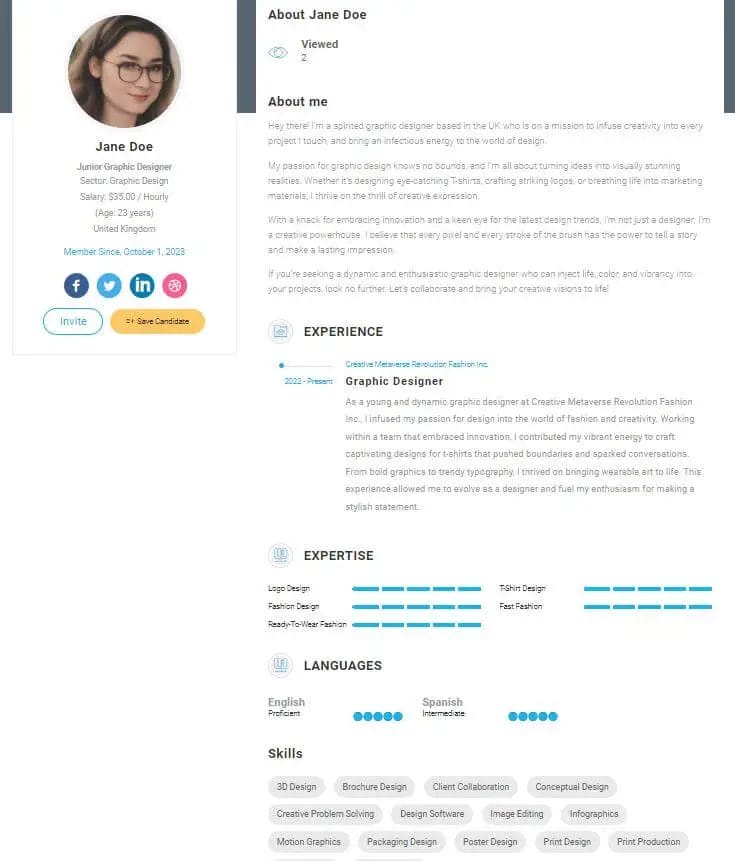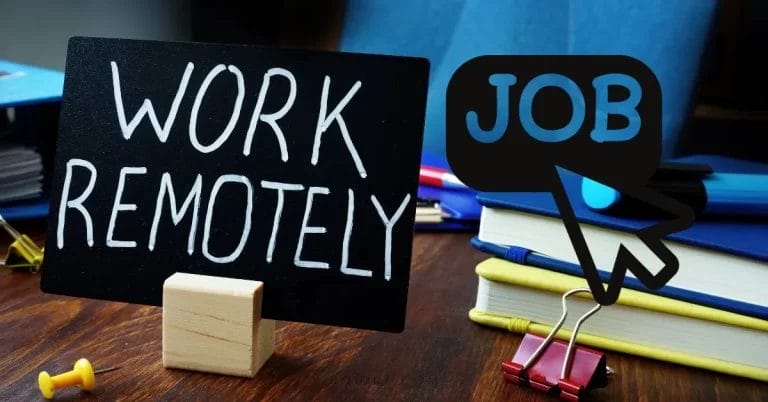|
Listen To Article
Getting your Trinity Audio player ready...
|
Are you a web designer looking for a remote web design job to get started with your design career?
Regardless, if you are a new web designer, experienced web designer or freelance web designer seeking remote positions, with these best web design job boards you can find clients faster and easier.
Best Remote Web Design Job Board for Web Designer and Developer
Web design is a key component of web development and mobile design. The visual design of a website revolved around user interface design, user experience design and the overall digital experiences of the website.
Here are some of the best job search sites for the web design and development professionals. Some even offers you the ability to create your own talent profile to gain more exposure.
1. HQHIRE: Elevating Your Remote Creative Journey
At the forefront of our exploration is HQHIRE, a distinctive remote job search site designed for creative professionals. Offering you the ability to create your own talent profile and get noticed by potential employers.
This remote job board caters specifically to remote creative professionals looking find freelance work and remote design work.
Why HQHIRE?
- Tailored for Creative Roles: HQHIRE focuses specifically on creative industries, ensuring a curated selection of job opportunities for web designers and related roles.
- Remote-Focused: With a dedicated emphasis on remote jobs, HQHIRE aligns with the preferences of those seeking flexibility in their work environment.
- User-Friendly Interface: The platform provides an intuitive and user-friendly experience, facilitating a seamless job search process.
Pros
- Tailored for creative roles, including web design, graphic design, UI/UX design.
- Focus on remote opportunities, aligning with your desire for a flexible work environment.
- User-friendly interface for seamless job browsing.
Cons:
- Potential for fewer job listings compared to broader platforms.
- Emphasis on remote opportunities may limit variety in job types.
- Less well-known compared to larger job boards.
With HQHIRE, you have the advantage of a niche platform that understands the nuances of the creative industry. The focus on remote positions aligns perfectly with the flexibility that web designers often seek in their work.
2. Upwork: A Global Freelance Hub for Web Designers
Now, let’s shift our focus to Upwork, a global freelance talent network that has become a go-to platform for many web designers.
Why Upwork?
- Job Variety: Upwork offers a wide range of job types, catering to freelancers, full-time, and part-time positions, including an extensive project catalog for web design gigs.
- Flexibility: Upwork provides flexibility in choosing job types, allowing users to explore remote, hybrid, or on-site opportunities.
- Global Freelance Network: As a global platform, Upwork connects web designers with clients worldwide, expanding the potential client base.
Pros:
- Wide range of job types, including freelancers, full-time, and part-time positions.
- Extensive project catalog for finding web design gigs.
- Flexibility in choosing job types, including remote, hybrid, or on-site.
Cons
- High competition for jobs may make it challenging for new freelancers.
- Varying job quality, with some opportunities having low budgets or unrealistic expectations.
- Requires strategic bidding to stand out from the competition.
Upwork opens doors to a myriad of opportunities, allowing you to choose the type of work that best suits your preferences. However, the competitive nature of the platform requires a strategic approach to stand out.
3. Fiverr: Unleashing Your Graphic Design Prowess
Fiverr takes a unique approach by offering a platform for buying and selling graphic design services. As a web designer, this opens up exciting possibilities.
Why Fiverr?
- Focus on Freelance Designers: Fiverr specializes in graphic design services, providing a platform for freelancers to offer and shape their unique services.
- Freelancer Empowerment: Fiverr empowers freelancers to build their client base and control their offerings within the platform structure.
- Individual Journey: The platform structure allows freelancers to create their own journey, setting their prices and shaping their freelancing experience.
Pros
- Focus on graphic design services, including web design.
- Opportunities for freelancers to offer their services, giving control over offerings.
- Platform structure empowers freelancers to shape their own journey.
Cons
- Effort required to build a client base, especially for new freelancers.
- May face challenges in setting competitive pricing.
- Some freelancers may find it challenging to stand out in a crowded marketplace.
Fiverr provides a space where your graphic design skills can shine. While building a client base may take effort, the platform’s structure empowers you to shape your freelance journey.
4. TopTal: Exclusivity and Quality for Web Designers
TopTal positions itself as a selective freelance marketplace, offering access to the top 3% of freelance talent. Let’s explore how this exclusivity can benefit web designers.
Why TopTal?
- High-Quality Projects: TopTal focuses on high-quality projects with reputable clients, ensuring a premium freelancing experience.
- Done-for-You Matchmaking: The platform streamlines the process with a done-for-you matchmaking system, sparing freelancers from extensive bidding efforts.
- Exclusivity: TopTal’s exclusivity ensures a focus on top-tier freelance talent, maintaining a high standard of expertise.
Pros
- High-quality projects with reputable clients.
- Done-for-you matchmaking process, saving time on bidding.
- Exclusivity ensures a focus on top-tier freelance talent.
Cons
- Low acceptance rate may make it challenging for less experienced freelancers.
- Locked into an hourly pricing model, limiting flexibility.
- Intense competition among top-tier talent.
TopTal sets a high standard for freelance talent, ensuring that you engage with quality projects and reputable clients. However, the selective nature may pose a challenge for acceptance.
5. Indeed.com: Navigating the Vast Sea of Job Opportunities
Indeed.com stands out as one of the largest job boards globally. As a web designer, tapping into this extensive platform can broaden your job search horizon.
Why Indeed.com?
- Large Job Pool: Indeed.com boasts a vast pool of job opportunities, including a substantial number of web designer positions.
- Easy Search Functionality: The platform provides easy search functionality based on keywords and location, streamlining the job search process.
- Well-Established: Indeed.com is a well-established platform with a wide user base, ensuring a diverse array of job listings.
Pros
- Large pool of job opportunities, including web designer positions.
- Easy search functionality based on keywords and location.
- Well-established platform with a wide user base.
Cons
- Potential for job redundancy due to the vast number of listings.
- Limited insights into company culture compared to dedicated company review platforms.
- Competition may be high for popular job listings.
Indeed.com offers a vast pool of opportunities, making it a valuable resource. However, due diligence is required to avoid redundancy in job listings.
6. Glassdoor: Illuminating Your Job Search Journey
Glassdoor is not just a job search engine; it’s a comprehensive platform providing company reviews, salary reports, and interview insights.
Why Glassdoor?
- Comprehensive Company Insights: Glassdoor provides in-depth insights into company reviews, salary reports, and interview insights, empowering informed job decisions.
- Holistic Approach: The platform takes a holistic approach, guiding users through the entire job search journey with rich information.
- Decision-Informing Data: Glassdoor equips job seekers with decision-informing data beyond job listings, fostering a comprehensive understanding of potential employers.
Pros
- Comprehensive insights into company reviews, salary reports, and interview insights.
- In-depth information for informed job decisions.
- Holistic approach to guide the job search journey.
Cons
- Job listings may be less extensive compared to dedicated job boards.
- Some information may be subjective and dependent on user reviews.
- Focus on company insights rather than job-specific details.
Glassdoor’s comprehensive approach equips you with the knowledge needed to make informed decisions. While job listings are available, the focus on company insights sets it apart.
7. Behance: Adobe’s Canvas for Web Designers
Behance, owned by Adobe, is a platform that seamlessly integrates with your Adobe design software subscription. Let’s explore how this affiliation can benefit web designers.
Why Behance?
- Adobe Affiliation: Behance’s affiliation with Adobe allows seamless integration with Adobe design software, enhancing the user experience.
- Diverse Opportunities: Behance offers diverse opportunities for designers in various creative fields beyond web design.
- Free Platform: Creating an account on Behance is free, making it accessible to a broad audience of designers.
Pros
- Adobe affiliation, allowing seamless integration with Adobe design software.
- Diverse opportunities for designers in various creative fields.
- Free platform for sharing work and finding inspiration.
Cons
- Requires an Adobe software subscription to unlock full features.
- Limited job board compared to dedicated job search platforms.
- Competition may be high for quality opportunities.
Behance serves as a canvas for your creative portfolio, with the added benefit of a job board that complements your Adobe design experience.
8. Envato Studio: Connecting Creatives and Clients
Envato Studio operates as a platform connecting clients with freelance designers. Let’s delve into the opportunities it presents for web designers.
Why Envato Studio?
- Diverse Opportunities: Envato Studio provides diverse opportunities for web designers in various categories, allowing exploration of different creative projects.
- Creative Connections: The platform facilitates connections between creatives and clients, fostering a collaborative environment.
- Project Variety: Envato Studio offers a variety of projects, enabling web designers to broaden their experience.
Pros
- Diverse opportunities for web designers in various categories.
- Platform facilitates connections between creatives and clients.
- Opportunity to explore various creative projects.
Cons
- May have fewer job listings compared to broader job boards.
- Competition may be high for popular project categories.
- Specific focus may limit the variety of job types available.
Envato Studio offers a space for web designers to explore diverse opportunities, though the platform’s focus may vary compared to broader job boards.
9. ZipRecruiter: Navigating the Sea of Freelance Web Design Jobs
ZipRecruiter emerges as an enormous job search platform, akin to Indeed, where you can find a multitude of freelance web design jobs.
Why ZipRecruiter?
- Vast Job Listings: ZipRecruiter boasts a vast array of job listings for freelance web design positions, ensuring a broad selection.
- Free Account Creation: Creating an account on ZipRecruiter is free, simplifying the application process for job seekers.
- User-Friendly Interface: The platform provides a user-friendly interface, enhancing the efficiency of job searches.
Pros
- Vast job listings for freelance web design positions.
- Free account creation for easy job applications.
- User-friendly interface for streamlined job searches.
Cons
- Potential for job redundancy due to the sheer volume of listings.
- Limited focus on specific details about company culture compared to dedicated platforms.
- Competition may be high for popular freelance opportunities.
ZipRecruiter’s expansive platform provides a constant stream of freelance web design opportunities, with the added benefit of a user-friendly interface.
10. PeoplePerHour: Unleashing Your Freelance Potential
PeoplePerHour stands as a global freelance marketplace that has thrived for almost 15 years. Let’s explore how it can be a platform for your freelance journey.
Why PeoplePerHour?
- Project Variety: PeoplePerHour offers a variety of project types for freelancers, allowing web designers to explore diverse opportunities.
- Popular Freelance Marketplace: As a global and popular freelance marketplace, PeoplePerHour connects freelancers with clients across the globe.
- Hourly and Fixed-Price Projects: The platform offers both hourly and fixed-price projects, providing flexibility for freelancers.
Pros
- Variety of project types available for freelancers.
- Popular freelance marketplace for diverse skills.
- Platform offers both hourly and fixed-price projects.
Cons
- High competition among freelancers may impact rates.
- Platform fees may be higher compared to other freelance marketplaces.
- Limited vetting process for freelancers may result in varied quality.
PeoplePerHour provides a diverse array of project types, but the competitive landscape and platform fees are factors to consider.
11. Jobster: Filtering Your Remote Web Design Opportunities
Jobster stands out as a job board that allows you to filter web design jobs based on company size, industry, and job type.
Why Jobster?
- Specific Filtering Options: Jobster offers specific filtering options for remote web designer jobs, enhancing the precision of job searches.
- User-Friendly Interface: The platform provides a user-friendly interface, simplifying the job search process.
- Tailored Job Searches: Jobster enables users to tailor job searches based on specific criteria, aligning with individual preferences.
Pros
- Specific filtering options for remote web designer jobs.
- User-friendly interface for streamlined job searches.
- Opportunity to tailor job searches based on specific criteria.
Cons
- Job listings may vary, impacting the availability of opportunities.
- Limited information about company culture compared to dedicated company review platforms.
- Platform may be less well-known compared to larger job boards.
Jobster’s focus on specific filtering options can streamline your search for web design positions, though the availability of listings may vary.
12. Remote OK: Specializing in Remote Opportunities
Remote OK positions itself as a platform connecting employers with talented remote workers.
Why Remote OK?
- Specialization in Remote Opportunities: Remote OK specializes in remote job opportunities, catering specifically to those seeking remote work.
- Streamlined Platform: The platform focuses on connecting employers with talented remote workers, streamlining the remote job search process.
- Diverse Remote Job Types: Remote OK caters to a variety of remote job types beyond web design, enhancing the range of opportunities available.
Pros
- Specialization in remote job opportunities.
- Streamlined platform for connecting employers with talented remote workers.
- Focus on a variety of remote job types.
Cons
- Limited focus on other job types beyond remote opportunities.
- Competition may be high for popular remote job listings.
- Platform may have fewer features compared to larger job boards.
Remote OK caters specifically to remote opportunities, making it an ideal platform for web designers seeking a location-independent work environment.
13. We Work Remotely (Graphic Design Jobs): Niche Focus for Graphic Designers
We Work Remotely stands out as a job board specifically for remote graphic design jobs, providing a niche focus for graphic designers.
Why We Work Remotely?
- Niche Focus on Remote Graphic Design: We Work Remotely specializes in remote-only graphic design opportunities, catering specifically to graphic designers.
- Specific Platform for Remote Work: The platform is dedicated to remote work, ensuring a focused environment for remote job seekers.
- User-Friendly Interface: We Work Remotely provides a user-friendly interface, simplifying the remote job search process for graphic designers.
Pros
- Niche focus on remote-only graphic design opportunities.
- Specific platform for remote work, catering to graphic designers.
- User-friendly interface for streamlined job searches.
Cons
- Limited variety in job types compared to broader job boards.
- Competition may be high for popular graphic design opportunities.
- Platform may have fewer features compared to larger job boards.
We Work Remotely caters specifically to graphic designers seeking remote opportunities, offering a specialized space in the job market.
14. Dribbble: A Showcase for Designers and Job Seekers
Dribbble is a creative haven for designers worldwide. Established in 2009, it has earned its place among the fastest-growing companies, attracting over 40,000 businesses, including giants like Facebook, Airbnb, and Shopify.
Why Dribbble?
- Portfolio Showcase: Dribbble offers a visually appealing space for designers to showcase their best work, creating an immersive experience for potential clients and collaborators.
- Freelance Job Board: Beyond a portfolio platform, Dribbble features a dedicated job board. Designers can explore freelance web design opportunities actively sought by various clients and companies.
Pros
- Visually Appealing Showcase: Dribbble’s visually appealing showcase allows designers to create an immersive experience for potential clients.
- Dedicated Job Board: The job board opens doors to various freelance opportunities, making it a one-stop platform.
Cons
- Pro Account for Job Postings: Access to job postings may require a Pro Business account, incurring additional costs.
Dribbble serves as both a showcase for your design portfolio and a job board for discovering freelance web design opportunities.
15. FlexJobs: Navigating the Flexible World of Remote Work
FlexJobs specializes in remote, freelance, part-time, or flexible work across various industries, including design. Let’s explore how FlexJobs can be your gateway to flexible opportunities.
Why FlexJobs?
- Focus on Remote Work: FlexJobs caters specifically to professionals seeking remote and flexible work arrangements.
- Diverse Categories: Covering over 50 categories, including graphic and web design, FlexJobs ensures web designers can find opportunities that match their skills.
Pros
- Remote Work Focus: Ideal for those seeking remote and flexible work arrangements, aligning with the trend of flexible working.
- Diverse Categories: Ensures web designers can explore opportunities beyond their immediate field.
Cons
- Subscription Fee: FlexJobs requires a subscription fee for full access, a factor to consider for potential users.
FlexJobs provides a curated platform for web designers seeking remote and flexible opportunities, offering a streamlined approach to the job search.
How to Start a Remote Web Design Career
Embarking on a remote web design and development career opens up a world of opportunities, allowing you to blend creativity with technical skills from the comfort of your own space. Here’s a simple guide to get started for web designers and developers.
1. Craft Your Online Presence
Begin by showcasing your skills through a well-crafted online portfolio.
Create a personal website with WordPress or create a talent profile that highlights your previous projects, technical expertise, and a bit about yourself.
This serves as your digital resume, allowing potential employers to explore your capabilities.
2. Define Your Niche
Identify your specific areas of interest within web design and development.
- Are you an expert in UX design or UI design?
- Are you good with front-end development?
- Are you a full-stack web developer?
Specializing yourself in one particular niche enhances your marketability. Highlighting your niche helps attract projects that align with your passions and strengths.
3. Skill Development
Stay on top of industry trends, understand graphic design principles and continuously upgrade your skills.
Platforms like Codecademy, Udemy, and Skillshare offer courses on various web development tools, languages, and design principles.
A diverse skill set enhances your versatility in tackling different projects.
4. Build a Strong Portfolio
Populate your portfolio with diverse projects that showcase your range and expertise.
Include detailed descriptions of your role in each project, the challenges faced, and the solutions implemented.
A compelling portfolio is your visual resume and a testament to your capabilities.
5. Network and Connect
Engage with the remote web design community.
- Join forums where web designers gather.
- Participate in webinars that talks about your niche.
- Connect with professionals on platforms like LinkedIn.
Networking opens doors to collaboration, mentorship, and potential job opportunities.
6. Explore Freelance Platforms
Kickstart your remote career by exploring freelance platforms like Upwork, Fiverr, or specialized sites like HQHIRE.
Create a profile that stands out, clearly outlining your skills, experience, and the value you bring to clients.
7. Remote Job Boards
Regularly check remote job boards dedicated in helping you find a remote job. This is where companies look to hire remote web designers.
These platforms cater specifically to remote opportunities, providing a centralized space to discover relevant web design projects.
8. Effective Communication
As a remote professional, effective communication is key.
Clearly articulate your ideas, project timelines, and expectations. Responsive and clear communication fosters trust with clients, contributing to successful collaborations.
9. Time Management
Working remotely requires effective time management.
- Set clear work hours
- Establish a dedicated workspace
- Adhere to project deadlines.
Time management is crucial for maintaining a healthy work-life balance.
10. Continuous Learning:
The field of web design and development evolves rapidly. Stay curious and committed to continuous learning. Follow industry blogs, attend virtual conferences, and adapt to emerging technologies to stay at the forefront of your field.
Time to Start Your Remote Web Design and Development Career
Starting a career as a web designers is possible when you know where to find the job opportunities.
Each job board platform has its unique features and advantages, catering to different aspects of your professional journey.
As you embark on your job search, consider the niche focus of platforms like HQHIRE, the broad opportunities on Upwork, the exclusivity of TopTal, and the comprehensive insights on Glassdoor.
Get stated in multiple job board is key to getting job offering.
- Understanding your preferences.
- Exploring diverse platforms.
- Showcase your skills.
Whether you’re a seasoned web designer or just starting, the digital job seas are vast, and the right opportunity awaits.
Get your 100% Free online resume and get noticed by potential employers. Start out of the crowded space of millions of remote job seekers and find the remote job that you will enjoy and love.

- 10 Best Remote Jobs for College Students That Pays Well (with Tips)
- 10 Best Remote Jobs with No Experience Required (+Pays Well)
- 21 Best Remote Jobs to Work From Anywhere (High Paying)
- 15 Best Remote Web Design Job Board (Freelance & Remote)
- 21 Best Freelance Writing Job Boards For Beginner Writers
Join over 11,000+ achievers who are committed to achieving their career goals!
Get your 100% Free online resume and get noticed by potential employers. Start out of the crowded space of millions of remote job seekers and find the remote job that you will enjoy and love.

Join over 11,000+ achievers who are committed to achieving their career goals!






